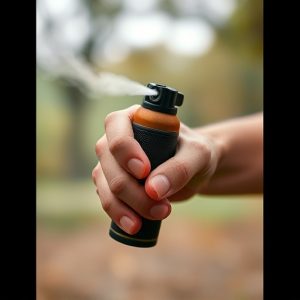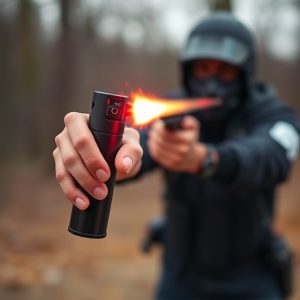Pepper Spray Defense: Detection, Removal, & Alternative Protection
Pepper spray, a common self-defense tool, uses capsaicin to temporarily disable attackers but can le…….
Pepper spray, a common self-defense tool, uses capsaicin to temporarily disable attackers but can leave residue on clothing, causing discomfort and potential skin irritation. To effectively Remove Pepper Spray From Clothing, take immediate action by rinsing affected areas with warm water and soap or using specialized neutralizers. Modern pepper spray detectors combine chemistry and technology to quickly break down capsaicin bonds and incorporate fabric cleaning properties. For post-exposure care, soak garments in cold water, use mild detergent, and wash separately until all residue is gone. Consider non-spray personal defense methods like alarms, whistles, keys, flashlights, or tasers for diverse scenarios and to address the challenge of removing pepper spray from clothing.
“Discover effective strategies to combat pepper spray attacks with our comprehensive guide. Understand the science behind pepper spray, its deterrence capabilities, and the immediate effects it has on the human body. Explore cutting-edge detectors designed to warn of impending threats. Learn practical steps to safely remove pepper spray from clothing. Furthermore, we compare non-spray personal defense options, offering insights into alternative measures for self-protection. For a detailed look at countering these potent deterrents, especially on sensitive fabrics, read on for our expert advice on how to effectively remove pepper spray from clothing.”
- Understanding Pepper Spray: How It Works and Its Effects
- The Science Behind Pepper Spray Detectors and Their Efficiency
- Step-by-Step Guide: Removing Pepper Spray From Clothing
- Alternative Measures: Non-Spray Personal Defense Options and Their Effectiveness Comparisons
Understanding Pepper Spray: How It Works and Its Effects
Pepper spray, a powerful deterrent, is designed to incapacitate and disorient an attacker, providing users with a crucial window of opportunity for escape or self-defense. Its primary active ingredient, capsaicin, is extracted from chili peppers and stimulates nerve endings in the eyes, nose, and respiratory system, leading to temporary blindness, tears, coughing, and difficulty breathing. This chemical irritant disrupts an attacker’s balance and coordination, allowing the user to gain distance or seek help.
Removing pepper spray from clothing after exposure is essential for safety and comfort. It can adhere strongly to fabrics, but various methods can be employed to eliminate its residual effects. Soaps and warm water are effective in washing away the spray, while certain neutralizing agents designed specifically for pepper spray can break down the capsaicin molecules more efficiently. Prompt action is key; rinsing affected areas immediately after exposure reduces the intensity of the irritant’s impact.
The Science Behind Pepper Spray Detectors and Their Efficiency
The science behind pepper spray detectors is a fascinating blend of chemistry and technology designed to neutralise and remove the effects of pepper spray from clothing and skin. These detectors work by identifying the key components of pepper spray, which primarily consist of capsaicin, a compound responsible for the burning sensation it causes. When activated, the detector releases an agent that either neutralises or washes away the capsaicin, rendering the spray ineffective. The efficiency of these devices lies in their ability to quickly and effectively break down the chemical bond of pepper spray, making them valuable tools for personal defence against such irritants.
Moreover, removing pepper spray from clothing is a crucial aspect of post-exposure care. Pepper spray particles can adhere strongly to fabrics, posing a risk of continued irritation or even inhalation if not properly addressed. Detectors that incorporate fabric cleaning or decontaminating properties play a significant role in ensuring individuals are fully protected and can continue their activities without discomfort or health risks associated with residual pepper spray.
Step-by-Step Guide: Removing Pepper Spray From Clothing
If you’ve been exposed to pepper spray while wearing clothing, it’s crucial to act quickly to remove the irritant. Here’s a step-by-step guide to help you effectively Remove Pepper Spray From Clothing.
1. Safety First: Put on protective gloves and eye protection to avoid direct contact with the pepper spray residue. Ensure the area is well-ventilated to minimize inhalation of the chemical.
2. Rinse Affected Areas: Hold the contaminated clothing away from your body and face. Rinse the affected areas under cool, running water for at least 15 minutes. This step helps to dilute and wash away the pepper spray.
3. Soak in Water: Soak the clothing in a large container of clean, cold water for an additional 10-15 minutes. This will help to further dissolve any remaining pepper spray particles.
4. Use a Mild Detergent: Gently rub a small amount of mild detergent on the affected areas. Avoid using harsh detergents or bleach as they can exacerbate the irritation.
5. Rinse Again: Rinse the clothing thoroughly in clean, cool water until all soap residue is removed.
6. Wash Separately: After rinsing, wash the clothing separately from other items in a washing machine using cold water and a gentle cycle. Avoid high heat or drying until the fabric is completely free of pepper spray residue.
Alternative Measures: Non-Spray Personal Defense Options and Their Effectiveness Comparisons
When considering personal defense options beyond pepper spray, it’s crucial to explore a range of alternatives. While pepper spray remains a popular choice for self-defense, there are non-spray methods that can be effective in deterring potential attackers. One key aspect to consider is the ease and effectiveness of removing pepper spray from clothing. Some options, like personal alarms or high-decibel whistles, can create a distraction without leaving traces on one’s garments.
Other alternatives include self-defense keys, flashlights, or even tasers, which can be powerful deterrents when used appropriately. These tools offer distinct advantages in various situations, especially in close-quarters combat or against multiple aggressors. Their effectiveness lies not only in their ability to incapacitate but also in their portability and readiness, ensuring individuals are prepared without relying solely on spray-based defenses.
In understanding the dynamics of self-defense, knowing how to remove pepper spray from clothing is a crucial step. The article has explored various aspects, from the mechanics of pepper spray and its detection to alternative personal defense options. For those who find themselves exposed, the step-by-step guide on removing pepper spray from clothing offers a practical solution. By equipping yourself with this knowledge, you’re better prepared to navigate potentially dangerous situations, ensuring your safety and peace of mind.


